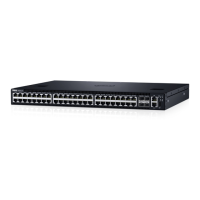Track IPv4 and IPv6 Routes
You can create an object that tracks an IPv4 or IPv6 route entry in the routing table.
Specify a tracked route by its IPv4 or IPv6 address and prex-length. Optionally specify a tracked route by a virtual routing and forwarding
(VRF) instance name if the route to be tracked is part of a VRF. The next-hop address is not part of the denition of the tracked object.
A tracked route matches a route in the routing table only if the exact address and prex length match an entry in the routing table. For
example, when congured as a tracked route, 10.0.0.0/24 does not match the routing table entry 10.0.0.0/8. If no route-table entry has the
exact address and prex length, the tracked route is considered to be DOWN.
In addition to the entry of a route in the routing table, you can congure how the status of a route is tracked in either the following ways:
• By the reachability of the route's next-hop router.
• By comparing the UP or DOWN threshold for a route’s metric with current entries in the route table.
Track Route Reachability
If you congure the reachability of an IP route entry as a tracked object, the UP/DOWN state of the route is determined by the entry of the
next-hop address in the ARP cache.
A tracked route is considered to be reachable if there is an address resolution protocol (ARP) cache entry for the route's next-hop address.
If the next-hop address in the ARP cache ages out for a route tracked for its reachability, an attempt is made to regenerate the ARP cache
entry to see if the next-hop address appears before considering the route DOWN.
Track a Metric Threshold
If you congure a metric threshold to track a route, the UP/DOWN state of the tracked route is determined by the current metric for the
route entered in the routing table.
To provide a common tracking interface for dierent clients, route metrics are scaled in the range from 0 to 255, where 0 is connected and
255 is inaccessible. The scaled metric value communicated to a client always considers a lower value to have priority over a higher value.
The resulting scaled value is compared against the threshold values to determine the state of a tracked route as follows:
• If the scaled metric for a route entry is less than or equal to the UP threshold, the state of a route is UP.
• If the scaled metric for a route is greater than or equal to the DOWN threshold or the route is not entered in the routing table, the state
of a route is DOWN.
The UP and DOWN thresholds are user-congurable for each tracked route. The default UP threshold is 254; the default DOWN threshold
is 255. The notication of a change in the state of a tracked object is sent when a metric value crosses a congured threshold.
The tracking process uses a protocol-specic resolution value to convert the actual metric in the routing table to a scaled metric in the
range from 0 to 255. The resolution value is user-congurable and calculates the scaled metric by dividing a route's cost by the resolution
value set for the route type:
• For intermediate system to intermediate system (ISIS), you can set the resolution in the range from 1 to 1000, where the default is 10.
• For OSPF, you can set the resolution in the range from 1 to 1592, where the default is 1.
• The resolution value used to map static routes is not congurable. By default, Dell Networking OS assigns a metric of 0 to static routes.
• The resolution value used to map router information protocol (RIP) routes is not congurable. The RIP hop-count is automatically
multiplied by 16 to scale it; a RIP metric of 16 (unreachable) scales to 256, which considers the route to be DOWN. For example, to
congure object tracking for a RIP route to be considered UP only if the RIP hop count is less than or equal to 4, you would congure
the UP threshold to be 64 (4 x 16) and the DOWN threshold to be 65.
530
Object Tracking

